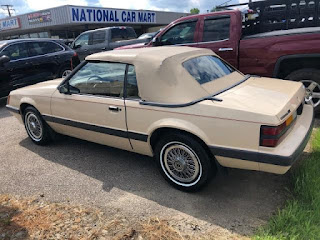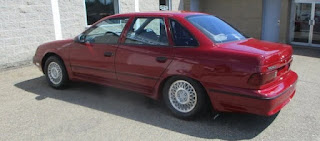Thursday, September 29, 2022
1989 Jeep Grand Wagoneer - Back in The Day, This Was Money
Wednesday, September 28, 2022
1986 Ford Mustang GT - Someone Else's Nostalgic Joyride
Thursday, September 22, 2022
1985 Ford Mustang LX Convertible - I Wish I Could Be That Kid
This 1985 Ford Mustang LX convertible got caught in one of my cheap car search nets recently. 60,000 miles or so on its thirty-seven-year-old analog ticker and an asking price of $7,900. Seems a tad high, honestly, but that's this used car market these days that while softening somewhat, don't hold your breath that prices will return to "normal". That said, what price would seem reasonable for this well persevered oldie?
Certainly, if there were "Five-point-Oh" badges on the front fenders and beefy alloys and real tires on it the price would be at least a third higher. Shoot, despite this awful, milk toast color, I'd be all over this myself if it was a "5.0" in this condition. Especially at this price. Then again, if it said Five-point-Oh on the sides, with the kind of mileage this has and priced at $7,900, I'd insist on making sure that there was, in fact, a god's green earth 5.0 under the hood.
Yeah, back in the day, some people did dress these up to look like the vaunted 5.0 Mustangs that not only terrorized Camaro and Firebird owners but went tailpipe-to-tailpipe with Corvettes for a stint in the mid-Eighties. Never made sense to me knowing that 5.0 Mustangs had very high theft rates then but live and let live. Whatever rows your boat. Or stable.
Ford offered the Mustang in three guises for 1985: LX, GT and SVO. A power convertible top option was available on LX and GT models. Said "Five-Point-Oh" engine, which denoted Ford's 302 cubic-inch V-8, was available on LX models but our subject here comes with Ford's 3.8-liter, sequential-fuel-injection, 120-horsepower, "Essex" V-6. I know. I thought it was a V-8 at first too but I checked the VIN number. Ford's 2.3-liter, "Lima" four-cylinder was the base engine in non-convertible LX models.
For my money back in the day, if I had any, I'd have opted for a Mustang LX convertible with the Five-point-Oh. As much as I'd find a stick-shift fun, knowing what traffic was on Long Island thisclose to Manhattan, I'd have opted instead for the automatic. For '85, Mustang's with the 5.0 and an automatic got fuel injected "high output" engines that made a very respectable, for the time anyway, 180-horsepower. 5-speed Mustangs got the carburetor equipped, 210-horsepower engines. Don't laugh or smirk. These cars weighed just a tad over three-thousand-pounds and stuffed with the 302, could do zero-to-sixty in around six seconds. Even today that's pretty darn quick.
Ah, the stuff of dreams. For me anyway. I couldn't come anywhere near a new one of these even a standard issue one with a V-6. God, those fake wires are hideous. And, yes, they're factory issue.
What's to become of this one? Gosh, good question. For sale up here in northeast Ohio, chances are it's been well preserved because convertible season up here is only slightly longer than pool season is. So, it's either going to someone who likes convertibles and is looking for a cheapie although, honestly, it's not a great car. The build structure is only so-so, it's pretty slow and it'll ride and handle like a truck with square wheels. My 2004 Mitsubishi Eclipse Spyder GTS it's most certainly not. Swapping in a proper engine and making the suspension right doesn't make financial sense either.
Would be a perfect first car for a kid who just got their license, though. I kind of wish I could be that kid too.













































